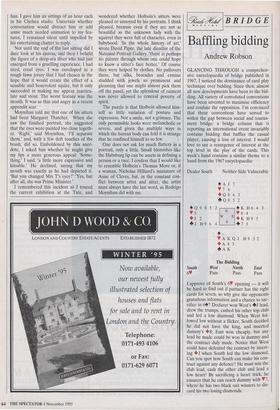Long life
Portrait of a donor
Nigel Nicolson
The artist was the late Rodrigo Moyni- ham I gave him six sittings of an hour each in his Chelsea studio. Uncertain whether conversation would distract him or add some much needed animation to my fea- tures, I remained silent until impelled by his entertaining chatter to reply.
Not until the end of the last sitting did I dare look at his canvas, and then I beheld the figure of a deep-sea diver who had just emerged from a gruelling experience. I had tired, cruel eyes. I was enveloped in a rough fawn jersey that I had chosen in the hope that it would create the effect of a sensible and benevolent squire, but it only succeeded in making me appear inarticu- late and stout. The worst feature was the mouth. It was as thin and angry as a recent appendix scar.
Moynihan told me that one of his sitters had been Margaret Thatcher. When she saw the finished portrait, she suggested that the eyes were painted too close togeth- er. 'Right,' said Moynihan, 'I'll separate them,' and, with a few deft touches of the brush, did so. Emboldened by this anec- dote, I asked him whether he might give my lips a more generous appeal: 'Some- thing,' I said, 'a little more expressive and kissable.' He declined, saying that my mouth was exactly as he had depicted it. `But you changed Mrs T's eyes?"Yes, but after all, she was Prime Minister.'
I remembered this incident as I toured the current exhibition at the Tate, and wondered whether Holbein's sitters were pleased or annoyed by his portraits. I think pleased, because even if they are not as beautiful as the unknown lady with the squirrel they were full of character, even in babyhood. 'In the whole history of art,' wrote David Piper, the late director of the National Portrait Gallery, 'there is perhaps no painter through whom one could hope to know a sitter's face better.' Of course they were helped by clothes. No pullovers there, but silks, brocades and ermine studded with jewels so prominent and gleaming that one might almost pick them off the panel, yet the splendour of raiment was never allowed to conceal poverty of spirit.
The puzzle is that Holbein allowed him- self so little variation of posture and expression. Not a smile, not a grimace. The only permissible looks were melancholic or severe, and given the multiple ways in which the human body can fold it is strange that he confined himself to so few.
One does not ask for much flattery in a portrait, only a little. Small blemishes like the Habsburg lip can be assets in defining a person or a race. I confess that I would like to resemble Holbein's Thomas More or, if a woman, Nicholas Hilliard's miniature of Anne of Cleves, but, in the constant con- flict between artist and sitter, the artist must always have the last word, as Rodrigo Moynihan did with me.











































































 Previous page
Previous page